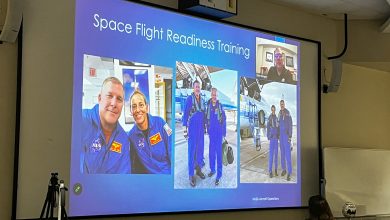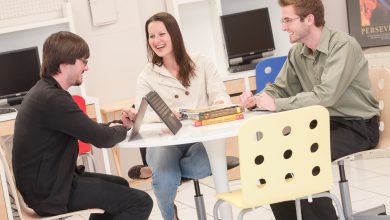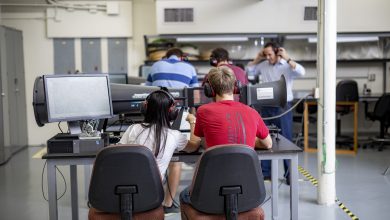Community Foundation of Brevard Grants $50,000 to Florida Techs Alzheimers Disease Research
MELBOURNE, FLA. — A $50,000 grant was just given to Florida Tech from the Community Foundation of Brevard’s Kenneth R. Finken and Dorothy Hallam Finken
Endowment Fund for research into the cause and cure of Alzheimer’s disease. The lead Florida Tech researcher is Dr. Shaohua Xu, associate professor of
biological sciences, who is already studying the origin of Alzheimer’s disease, using atomic force microscopy to test his unique theory.
President of the Foundation Gary Lang said, “This is an example of individual philanthropy at its best. The Community Foundation of Brevard is proud of its
association with the family and their special support for this very worthwhile research program.”
Finken was a graduate of Columbia University, held four patents and was retired from Harris Corporation, Government Electronic Systems.
Xu’s theory explains why, in the brain cells of victims of Alzheimer’s, molecules of a normal protein called “tau” do something very abnormal: they join
together to form tangled fibers that the cell cannot remove. The fibers accumulate until essential substances cannot move through the cell and the cell
dies. As brain cells are lost, memory and mental functioning deteriorate.
“Confirmatory evidence is essential,” said Xu. “Two proteins aggregate into toxic fibers in Alzheimer’s disease. We have shown that one protein, tau,
aggregates by a colloidal process. Under this grant we will be able to provide strong evidence for the theory by showing that the second Alzheimer’s
protein, A-beta, also forms fibers following the same pathway.”
The grant will make it possible to add critical equipment to the laboratory, including a Bio-Tek Microplate Reader for measuring critical reaction rates.
It will allow us to analyze the factors that accelerate the formation of fibers, which may be risk factors, and permit screening potential drug molecules
that might inhibit the fiber formation process. The grant will also fund materials and supplies critical for the research and will support a graduate
student researcher who will be an important member of the research team.
Xu’s research is conducted both at Florida Tech and the Space Life Sciences Laboratory, a unique research facility at Kennedy Space Center (KSC) operated
by the State of Florida in partnership with NASA and Florida universities. At KSC he uses a state-of-art Atomic Force Microscope, one of the few in
Florida, to study the mechanism of Alzheimer’s.
The usual theory of Alzheimer’s origin is that the abnormal filaments form by the addition of individual tau molecules to the tip of the fiber.
“From our own observations, we believe this theory is incorrect,” says Xu. “The process we have observed more closely resembles the behavior of colloids,
mixtures like milk or ink in which tiny particles are suspended in a fluid. We found that the protein molecules first stick together to form spherical
colloidal particles, far too small to see with an ordinary microscope, which then join like beads on a string to form the filaments that choke the cell.
Our theory is based on colloid science.”
Xu began developing this theory in 1997, when he was studying Mad Cow Disease at the University of Chicago. The theory may provide an explanation not only
for Alzheimer’s and Mad Cow Disease, but also for Parkinson’s disease and several other diseases in which proteins form similar abnormal clusters. Xu
affirms that if his theory is correct, it may be possible to halt the disease with drugs that prevent the particles of protein from joining into chains.
Daniel Woodard, a physician at Kennedy, was the first medical doctor to review the research. He says, “Shaohua’s theory is revolutionary; his evidence is
overwhelming. The medical implications are beyond anything in my experience.”
NASA physician David Tipton, chief of the Aerospace Medicine and Environmental Health Branch at KSC, says, “This could be the most important biomedical
discovery ever made at Kennedy Space Center.”
Additionally, Pamela Tronetti, medical director of the Parrish Senior Consultative Center, predicts, “If this theory is correct, it could have as great an
impact on neurodegenerative disease as the discovery of germs had on infection.”
Working with Xu are former astronaut Sam Durrance, now a professor of physics and space sciences at Florida Tech, and a team of talented graduate and
undergraduate student researchers.




